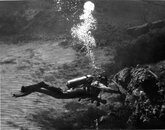Just to add a bit to what Herman said, there were a few double hose regulators in the 1960s and 1970s that did have both HP and LP ports. One was the AMF Voit Trieste regulator, which also was a bit of a hard breather due to a few design problems (ineffective venturi, stiff diaphragm). Another was the Sportsways HydroTwin and Duel Air regulators, but these are very pricy now and also very hard to find. The photo of me by Bruce Higgins below shows me using a single 80 cubic foot steel tank, with my Trieste II regulator (that I still dive), with an octopus, inflator and SPG in 1975 or so. I'm also in an Aquala dry suit, over a farmer John bottom wet suit with a sweater.
If you want another good read, and it illustrates the history of scuba, pick up
The Silent World, by Jacques Cousteau. When I started diving in 1959, at the age of fourteen (buying my used scuba gear with bean and strawberry picking money made during that summer), I read this book several times before actually diving. Believe it or not, it is not only entertaining, but also gives a lot of basic dive safety information too (through experience, some of it not-so-good experience). I started on a double hose regulator, and was certified in scuba some four years later. But at that time, there were no instructors in my area, we had to import Roy France from LA County to do our instruction. So you have a leg up on me, as you have already gotten the instruction.
The basics are all the same between single hose and double hose diving. The only difference is that with the double hose regulator, you have two non-return valves in the mouthpiece, one on the intake (right hose) and one on the exhalation side of the mouthpiece (left side hose). The mouthpiece should be balanced so that it does not cause any pull up or down in your mouth (loosen the hose clamps, and balance the mouthpiece on your finger horizontally with the regulator about four inches below, then tighten the clamps again--don't forget that part

). To clear the mouthpiece, simple tilt your head left-side down, then blow. Alternatively, lift the mouthpiece above the regulator and let water pressure initiate a free flow, then put the mouthpiece in your mouth. The other noticeable difference is the bubbles behind your head, instead of in your face.
Try your rig out in the pool for several times before taking it into open water. I call this "qualifying" the rig, but it is also to get you used to the gear in a supervised environment.
'Hope this helps. Come back and talk about it if you decide to buy used gear, as there are several things about used double hose regulators you need to be aware of. Also, the maintenance on a double hose is a bit different than on a single hose regulator.
SeaRat




